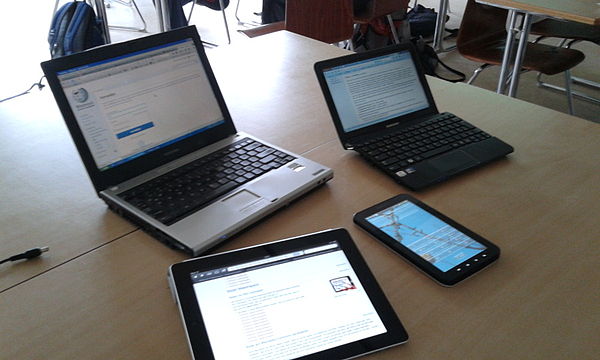Instructional design/Tablet Technology/Introduction
Introduction
[edit | edit source]The use of tablet in K-12 classroom
[edit | edit source]Mobile technologies have significantly developed and improved in past decades. It has impacted society in many ways. It is said that mobile technologies provide us with new opportunities, patterns of work, lives, and entertainments in academic and professional fields as well as in our daily lives. Mobile technologies enable people to utilize mobile devices as communication and collaboration tools.
Possibilities
[edit | edit source]Mobile learning may have created new possibilities to take advantage of its technological innovations to enhance learners’ creative/critical thinking, positive attitude [1], spatial ability, and executive function [2] as well as learner engagement [3].
Mobile learning games can be motivating for learners, providing satisfaction and desire to recommend it to others and to play again [4]. There are mobile collaborative learning applications to promote higher-order thinking skills, such as discussion boards, blogs, outdoor education scenarios, and games [5]. Since mobile devices have the capacity to support a sense of individuality and community as well as learner motivation to learn through participation in collaborative learning [6].
Tablets
[edit | edit source]With the development of mobile technologies, specifically, tablets have created new instructional ideas.
Researchers in the mobile learning field have investigated how tablet technologies can enhance and improve the way people learn as well as interact each other. In the mean time, students’ use of tablet devices in classroom has encouraged their teachers to redesign traditional instruction. Tablet technologies can create an opportunity for students and teachers in classroom settings by supporting engagement, participation, interactions, or individualized learning.
Reflection
[edit | edit source]Let’s think about the following topics.
- How many of your students have their own tablets?
- Have you ever thought about the use of tablets in your classroom?
- If so, what was the instructional goal of using tablets? How was it?
- If not, why haven’t you used it?
References
[edit | edit source]- ↑ Cavus, N., & Uzunboylu, H. (2009). Improving critical thinking skills in mobile learning. Procedia-Social and Behavioral Sciences, 1(1), 434-438.
- ↑ Song, D., Karimi, A., & Kim, P. (2011). Toward designing mobile games for visually challenged children. Proceedings of the IEEE International Conference on e-Education, Entertainment and e-Management (pp. 234-238), Bali, Indonesia.
- ↑ Song, D., Kim, P., & Karimi, A. (2012). Inquiry-based learning environment using mobile devices in math classroom. Paper presented at the Annual Convention of the Association for Educational Communications and Technology (AECT), Louisville, Kentucky.
- ↑ Sánchez, J., Salinas, A. & Sáenz, M. (2007). Mobile game-based methodology for science learning. In J. Jacko (Ed.). Human Computer Interaction, Part IV, HCII 2007, LNCS 4553 (pp. 322-331). Heidelberg, Berlin: Springer.
- ↑ Cheong, C., Bruno, V., & Cheong, F. (2012). Designing a mobile-app-based collaborative learning system. Journal of Information Technology Education: Innovation in Practice, 11, 97-119.
- ↑ El-Hussein, M. O. M., & Cronje, J. C. (2010). Defining mobile learning in the higher education landscape. Educational Technology and Society, 13(3), 12-21.
| ID Homepage | Tablet Technology | Next > |


